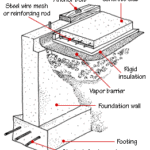Insulation saves you money and makes your home more comfortable by minimizing heat (or cooling) loss and reducing drafts. By slowing or reducing the movement of heat through the walls, ceilings, roofs, and floors of a house, insulation gets the most out of your energy dollars. Although all house-building materials slow the movement of heat to some extent, insulation products provide an especially effective barrier that retards heat transfer. Basically, it keeps expensively warmed or cooled air inside the house where it belongs.
How Heat Travels
Heat seeks a balance. This means that warm air always moves from a warm place to a colder one, and vice versa. The greater the difference, the faster the air moves. This is how drafts are created indoors and why cold outdoor air moves through an open window on cold days.
As shown in the illustration, heat travels by radiation, convection, and conduction.
Radiation. Radiant heat from the sun or from a radiant heater travels in a straight line to warm cooler objects—such as roofs, walls, even people—rather than the air. Those objects absorb the heat and may re-radiate it to other cooler surfaces. Although the air temperature may be chilly, you an still feel warm with radiant heating.
Convection. Heat rises. In a room, warm air moves toward the ceiling, and cool air moves toward the floor. This movement, called convection, carries heat through the air, particularly through large, enclosed spaces where air moves freely. As warm air rises, it gives off heat to the surfaces around it, causing it to cool, sink, and be replaced by warmer rising air.
Conduction. A frying pan on a stove heats by conduction, where heat from the source (the burner) travels through a solid material (the pan). Generally speaking, the denser the material, the better it conducts heat. A black metal roof will conduct enough heat to burn you if you touch the underside on a hot day. Foam board insulation, which is not dense at all, would remain cool to the touch.
How Home Insulation Works
Insulation is manufactured from a variety of different materials in several forms: batts and blankets, loose-fill, blown-in, plastic foam, rigid boards, and reflective radiant barriers. For more about these, see Types of Insulation. Some are better that others at minimizing heat transfer through radiation, conduction, or convection. For example, reflective foil radiant barriers reject radiant heat from the sun before it has a chance to be conducted into the house. Foam insulation boards are great at slowing conduction through roofs and walls.
Just how well a particular insulation slows heat transfer depends upon the material. Some of the favorites are fiberglass in blankets and batts (easiest for do-it-yourselfers to install), loose-fill and blown-in cellulose and pellet materials, and foam.
Insulation R Values
The effectiveness of insulation is rated by R-values. The higher the R-value, the greater the material’s ability to insulate. Each inch of fiberglass blanket insulation, for example, provides an R-value of about 3.27. Loose-fill insulation can vary from about 2.2 to 4.0, depending on how effectively it is installed. Sprayed polyurethane foam can be rated as high as 6.0 to 7.3. For a more in-depth comparison of different kinds of insulation, see the House Insulation Buying Guide.
Some types seal out air infiltration, a major contributor to heat loss. Just how well insulation resists heat flow is measured and rated by an R-value. Insulation materials differ in their R-values per inch of thickness.
Home Insulation Tips
Insulation should be installed inside any barrier that’s located between heated and unheated spaces. In essence, it should form an envelope around a home.
The attic is the most important place for insulation. Buttoning up an uninsulated attic can cut fuel bills by 30%. Bringing a minimally insulated attic up to optimum insulation levels can yield comparable results relative to the amount added. And, if an attic is unfinished, insulating it is a relatively easy job.
If an attic is finished with walls and ceilings, insulation should be installed in the end and knee walls, the ceiling joists beyond the knee walls, and, if possible, between rafters of the attic ceiling (however, ventilation between the rafters from the eaves to the ridge should not be blocked).
It’s also important for house walls to be insulated, but, in an older, uninsulated house, this doesn’t always pencil out. Insulating walls during construction before wall coverings are applied is a breeze, but insulating them after the fact is an expensive and complicated proposition (unless you’re remodeling or re-siding the house). If your home has uninsulated walls and is located in a cold climate, ask two or three insulation contractors for bids, and then figure out how long it will take to pay back the cost at a savings of 16% to 20% per year on your energy bill.
Insulating crawlspaces is also helpful; doing so can trim 5% to 15% off heating costs. If crawlspaces are reasonably accessible, insulating is generally pretty easy. Outer walls and foundations in finished basements also should be insulated.



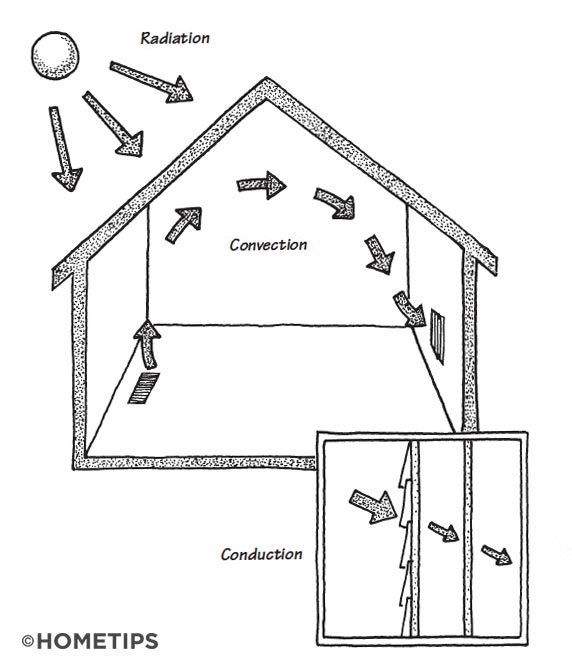
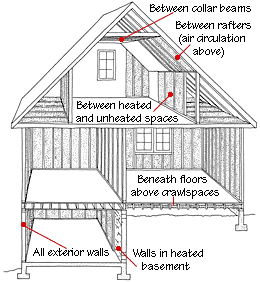
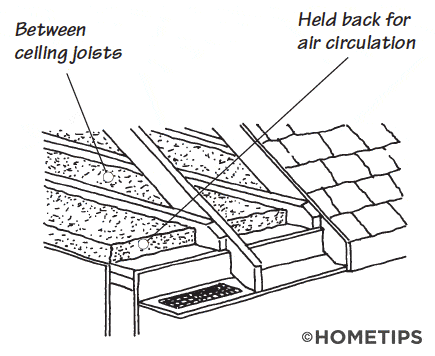



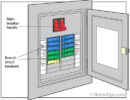
 Don Vandervort writes or edits every article at HomeTips. Don has:
Don Vandervort writes or edits every article at HomeTips. Don has:



